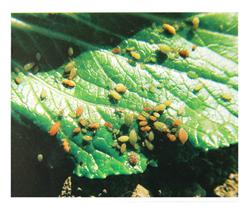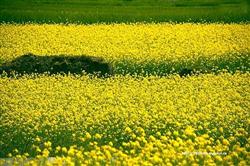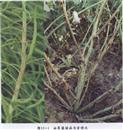Control techniques of rape aphids

Aphids, commonly known as greasy insects, are the main insect pests of rape in Linxiang area, which occur in the main producing areas of rape. When the drought is serious in winter and spring, the insect pests are more serious in the plots lacking irrigation conditions. The harm of aphids mainly occurs in the period from bolting to maturity of rape, and some yield losses will be caused if the control is not timely or improper. First, rape aphids are suitable for warm and dry climates. the climate in spring and autumn is warm, which is most suitable for their growth and reproduction, so the damage is generally serious in late spring, early summer and autumn. Aphids gather on the back of rape leaves, tender stems, buds and flowers with adult or nymph aphids, and suck the sap of the plant with needle-like sucking mouthparts, so that the cells are destroyed, the growth is out of balance, the leaves curl and wrinkle to the back, and the growth of heart leaves is shaded. In serious cases, the plant stops growing, and even the whole plant wilts and dies. When damaged by aphids, a large amount of water and honeydew are discharged and dripped on the lower leaves, causing fungal disease, hindering the physiological function of leaves and reducing the accumulation of dry matter. Due to migration and spread when looking for host plants, many kinds of plant virus diseases can be transmitted, causing more damage. 2. Control methods: 1. During the growth period of rape, remove weeds in the field and nearby, combine with inter-seedling to fix seedlings or transplant, and remove aphids. Cover with medicine and soil after sowing and spray insecticide before transplanting. Cultivate the soil in time, cultivate strong seedlings, reasonably close planting, increase the ventilation and transparency of the field. 2. Yellow board traps and kills aphids. At the rape seedling stage, the yellow plate was set at the edge of the ground by using the plastic film of 0.33m2, painted golden yellow, and then coated with a layer of Vaseline or engine oil, which could trap a large number of winged aphids at a height of 0.5m above the ground. 3. Pesticide prevention and control. At the seedling stage, the rate of aphids reached 10%, the population density was 1 to 2 per plant, 10% of the inflorescences of stem branches at bolting and flowering stage had aphids, and 3 to 5 aphids per branch began to spray. 10% imidacloprid 20 g per mu, or 4.5% cypermethrin 30 ml, or 3% acetamiprid EC 40 mi 50 ml, or 50% aldicarb wettable powder 10 mi 18 g, or 2.5% kungfu EC 10 Mel 20 ml, etc., can be used for water spray control.
- Prev

Re-application of Boron in rape with High quality, High yield and stable yield
Rapeseed (Brassica napus L.) is a boron-demanding crop, especially high-yield and high-quality Brassica napus "double-low" hybrid rape is particularly sensitive to boron deficiency, slow rooting at seedling stage, dark green, wrinkled leaves and hindered growth; boron deficiency at bud stage, rhizome expansion, leaf color turning purple to blue-purple, abnormal flower bud development; boron deficiency at flowering stage, plant dwarfing, pollen.
- Next

Broad-leaved weeds can be removed in rape growing period.
Sclerotinia sclerotiorum is one of the most important diseases in rape production, which may occur from seedling stage to maturity, especially in stem. Control methods: first, increase the application of phosphorus and potassium fertilizer, a small amount of nitrogen fertilizer, at the same time to open soil moisture to facilitate drainage, good seedlings, maintain reasonable density, spray paclobutrazol to improve lodging resistance, reasonable density.
Related
- The first cup of black tea in spring, the flavor and history of tea gardens in Kenya, Africa
- The computer can not only choose potatoes, but also grow tea rice. AI will grow winter oolong tea champion.
- It is not only the inflated tea bitten by insects, but also engraved with the four seasons tea in Beipu.
- The Oriental Beauty Tea Festival in Zhuxian County takes the stage at the weekend to experience the plus-size feast of oil tea.
- & quot; Oriental Beauty Tea & Exploration of Emei in Hsinchu, the hometown of quot;
- The new variety of strawberry "Tainong 1" dessert is the first choice with mellow aroma. Crimson gorgeous
- History of Tea in Taiwan: from Wild Inner Mountain to Export Tea Garden
- Two types of Taiwan Oriental Beauty Black Tea won the British three-Star Award for Childhood Tea Xiang Zhang Jiaqi changed from pilot to champion tea maker.
- Banana species and varieties: the planting history of Taiwan Xianren banana and dwarf banana is long, is banana disease resistant?
- Coffee planting Technology: Qianjie Coffee from Seedling to harvesting

